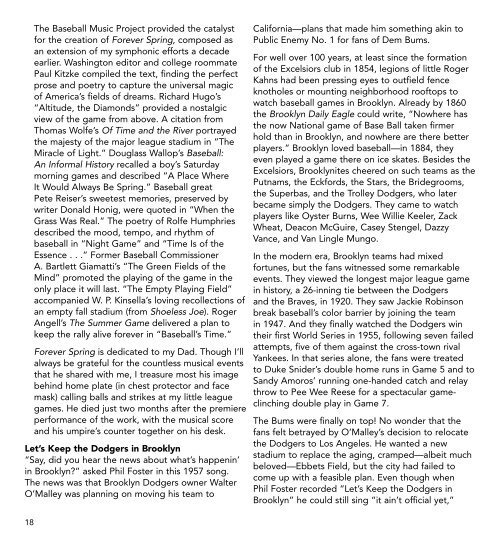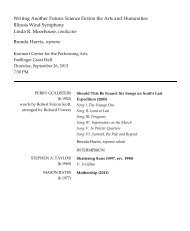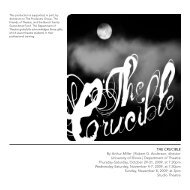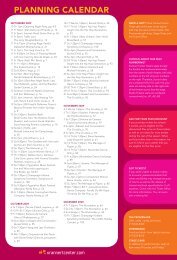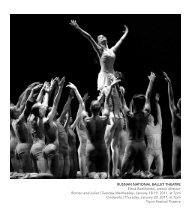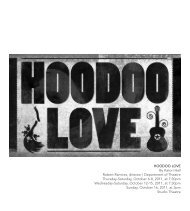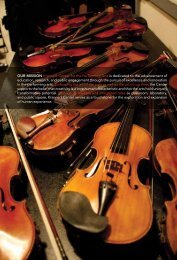THE BASEBALL MUSIC PROJECT Bob Thompson, conductor ...
THE BASEBALL MUSIC PROJECT Bob Thompson, conductor ...
THE BASEBALL MUSIC PROJECT Bob Thompson, conductor ...
Create successful ePaper yourself
Turn your PDF publications into a flip-book with our unique Google optimized e-Paper software.
The Baseball Music Project provided the catalystfor the creation of Forever Spring, composed asan extension of my symphonic efforts a decadeearlier. Washington editor and college roommatePaul Kitzke compiled the text, finding the perfectprose and poetry to capture the universal magicof America’s fields of dreams. Richard Hugo’s“Altitude, the Diamonds” provided a nostalgicview of the game from above. A citation fromThomas Wolfe’s Of Time and the River portrayedthe majesty of the major league stadium in “TheMiracle of Light.” Douglass Wallop’s Baseball:An Informal History recalled a boy’s Saturdaymorning games and described “A Place WhereIt Would Always Be Spring.” Baseball greatPete Reiser’s sweetest memories, preserved bywriter Donald Honig, were quoted in “When theGrass Was Real.” The poetry of Rolfe Humphriesdescribed the mood, tempo, and rhythm ofbaseball in “Night Game” and “Time Is of theEssence . . .” Former Baseball CommissionerA. Bartlett Giamatti’s “The Green Fields of theMind” promoted the playing of the game in theonly place it will last. “The Empty Playing Field”accompanied W. P. Kinsella’s loving recollections ofan empty fall stadium (from Shoeless Joe). RogerAngell’s The Summer Game delivered a plan tokeep the rally alive forever in “Baseball’s Time.”Forever Spring is dedicated to my Dad. Though I’llalways be grateful for the countless musical eventsthat he shared with me, I treasure most his imagebehind home plate (in chest protector and facemask) calling balls and strikes at my little leaguegames. He died just two months after the premiereperformance of the work, with the musical scoreand his umpire’s counter together on his desk.Let’s Keep the Dodgers in Brooklyn“Say, did you hear the news about what’s happenin’in Brooklyn?” asked Phil Foster in this 1957 song.The news was that Brooklyn Dodgers owner WalterO’Malley was planning on moving his team toCalifornia—plans that made him something akin toPublic Enemy No. 1 for fans of Dem Bums.For well over 100 years, at least since the formationof the Excelsiors club in 1854, legions of little RogerKahns had been pressing eyes to outfield fenceknotholes or mounting neighborhood rooftops towatch baseball games in Brooklyn. Already by 1860the Brooklyn Daily Eagle could write, “Nowhere hasthe now National game of Base Ball taken firmerhold than in Brooklyn, and nowhere are there betterplayers.” Brooklyn loved baseball—in 1884, theyeven played a game there on ice skates. Besides theExcelsiors, Brooklynites cheered on such teams as thePutnams, the Eckfords, the Stars, the Bridegrooms,the Superbas, and the Trolley Dodgers, who laterbecame simply the Dodgers. They came to watchplayers like Oyster Burns, Wee Willie Keeler, ZackWheat, Deacon McGuire, Casey Stengel, DazzyVance, and Van Lingle Mungo.In the modern era, Brooklyn teams had mixedfortunes, but the fans witnessed some remarkableevents. They viewed the longest major league gamein history, a 26-inning tie between the Dodgersand the Braves, in 1920. They saw Jackie Robinsonbreak baseball’s color barrier by joining the teamin 1947. And they finally watched the Dodgers wintheir first World Series in 1955, following seven failedattempts, five of them against the cross-town rivalYankees. In that series alone, the fans were treatedto Duke Snider’s double home runs in Game 5 and toSandy Amoros’ running one-handed catch and relaythrow to Pee Wee Reese for a spectacular gameclinchingdouble play in Game 7.The Bums were finally on top! No wonder that thefans felt betrayed by O’Malley’s decision to relocatethe Dodgers to Los Angeles. He wanted a newstadium to replace the aging, cramped—albeit muchbeloved—Ebbets Field, but the city had failed tocome up with a feasible plan. Even though whenPhil Foster recorded “Let’s Keep the Dodgers inBrooklyn” he could still sing “it ain’t official yet,”by the end of the year it was. The Boys of Summerwould play in Brooklyn no more. Since the New YorkGiants announced their move to San Francisco thatsame year, 1957 truly marked the end of an era forbaseball in New York City.Van Lingle MungoWho better to tell the story of a song than thecomposer himself? We may not be able to ask JackNorworth and Albert Von Tilzer about “Take Me Outto the Ball Game,” but we can ask Dave Frishbergabout one of his most popular songs, which alsohappens to be a classic baseball tune. Below,Frishberg talks about how he came to write “VanLingle Mungo.”In 1969, I was working as a pianist in New York Cityand beginning to write songs. I composed a ratherbrooding melody in what I considered a “BossaNova” style—a wide ranging melodic line and awandering tonal center. I equipped the melodywith two different lyrics; one was an angry satiricalmessage to Richard Nixon; the other was called“Don’t Look behind You” and soberly implored thelistener to face the future. Neither lyric seemed tomatch the fancy melody line.One night I was paging through the newlypublished Macmillan Baseball Encyclopedia andmy gaze fell on the name Van Lingle Mungo, starfireball pitcher with the Brooklyn Dodgers and NewYork Giants during the 1930s and World War II.“Van Lingle Mungo”—the name scanned perfectlywith a recurring melodic figure in my song, andI instantly sang it out loud. I knew then that thelyric had to be only names—not names of famousstars, but names that evoked musty memories andilluminated some fragments of forgotten baseballhistory. I dived into the book assembling namesthat scanned, rhymed and related loosely to thoseyears, the years of my childhood passion for thegame. Within a couple of hours I had a completelyric.About a month later I recorded an album of mysongs including “Mungo,” and that turned out tobe the only track that got any airplay.I edited the lyrics in subsequent years and, in myopinion, improved the song. I took out certainnames from the original lyric and replaced themwith names from an earlier (wartime) era so thatthe nostalgic focus would be sharper.Johnny Kucks and his rhyme mate Virgil Truckshad to go and were replaced by Lou Boudreauand Claude Passeau. The replacement of RoyCampanella’s conveniently rhyming name wasnecessary because he was too recent. So I changedit to Art Pasarella (an umpire), and that seemed todo the job: Gardella, Pasarella, and Estalella.I subsequently learned that <strong>Bob</strong> Estalella’s namedidn’t rhyme in the first place, because it waspronounced as in Spanish: Esta-leya. So thewhole rhyme scheme should have been scrapped,starting with “Danny Gardella.” What did I know?I grew up in a minor league town and never heardEstalella’s name uttered, only saw it in print. Samegoes for Johnny Gee, whose name I mangled onthe record with a soft “g.” There may be othernames I’m mispronouncing, but at this stagefurther corrections would only confuse me.In my search for names that scanned, “JohnAntonelli” was an unfortunate choice, and it’sannoying that he’s in the song, because thereturned out to be two John Antonellis whose majorleague careers nearly overlapped. I was thinkingof the third baseman Antonelli who was up brieflywith the Cardinals and Braves during the war. Iwasn’t even aware of the more famous JohnnyAntonelli—the left hander for the Giants. By thetime Antonelli #2 came along I had traded DukeSnider for Duke Ellington.18 19


